Runs on a MacBook (macOS 11+) or any laptop (Windows 7/8/10/11) with a standard 802.11be/ax/ac/n/g/a/b wireless network adapter. Read more about the 802.11be support here.
Top 7 Best Wi-Fi Booster Apps in 2025
Is your Wi-Fi signal letting you down? No need to rush for a new router! Check out these top 7 Wi-Fi booster apps that help optimize your current setup for better range, strength, and reliability.
Wi-Fi troubleshooting with the best Wi-Fi signal booster apps is a surprisingly straightforward process, especially if you take the time to familiarize yourself with the most effective Wi-Fi booster techniques...
In this review, we've highlighted the most popular tools. We tested them in real-world conditions and assessed their ease of use for regular users and how clearly the app displays scan results. We also paid attention to support for modern standards (Wi-Fi 6, 6E, and 7), channel information, and the absence of intrusive in-app ads.
What Are the Best Wi-Fi Booster Apps
The good news is that the best Wi-Fi booster apps available are neither expensive nor difficult to use, as demonstrated by our top pick: NetSpot.
- NetSpot — is our favorite Wi-Fi booster app because it has successfully combined professional features with simplicity and usability.
- Wireshark — is a free and open source packet analyzer used by network administrators and other IT professionals for network troubleshooting and analysis.
- Acrylic Wi-Fi Analizer — is a Wi-Fi network scanner for Windows capable of scanning 802.11a/b/g/n/ac/ax networks on 2.4, 5 and 6 Ghz wireless frequencies, providing essential tools for network optimization.
- Wi-Fi Analyzer (for Android) — is a popular Android Wi-Fi booster app that you can use to discover Wi-Fi networks in your area to pick the least cluttered channel for your own network.
- Wi-Fi Analyzer (for Windows) — is a simple utility for quick discovery of nearby WiFi networks.
- WiFiman — is a straightforward option for checking and tweaking Wi-Fi. It helps you gauge signal strength, test speeds, and spot congestion, making it easier to fix issues and improve reliability.
- Connection Stabilizer Booster — suits Android users by maintaining a steady signal and reducing dropouts.

NetSpot is our favorite Wi-Fi booster app because it has successfully combined professional features with simplicity and usability. The app is ideal for beginners and professionals alike, offering advanced tools for creating heatmaps, analyzing Wi-Fi coverage, and optimizing network performance. The application offers three Wi-Fi analysis modes:
-

Inspector Mode
Gives you real-time insights into the WiFi networks around you.
-

Survey Mode
Provides a comprehensive, map-based analysis of your WiFi network's performance.
-

Planning Mode
Enables you to simulate and plan your WiFi network's layout and coverage.
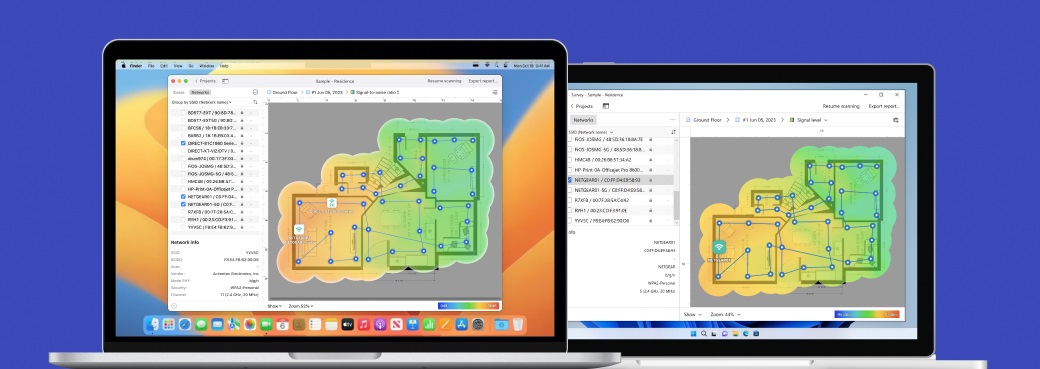
NetSpot works on Wi-Fi-capable Windows, macOS, iOS, and Android devices, making it one of the most flexible Wi-Fi booster apps around and a top choice for anyone seeking a better wireless experience.
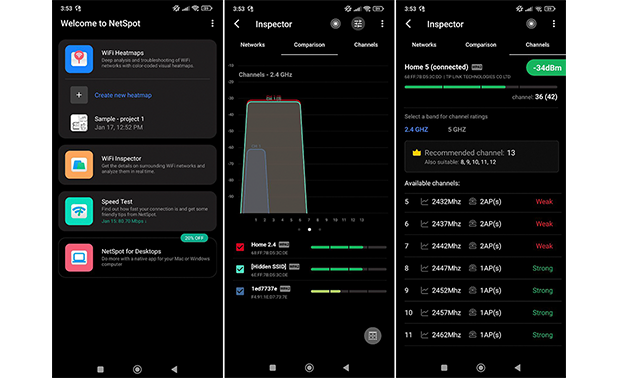
For Android users, NetSpot includes a feature that recommends the best Wi-Fi channel to minimize interference. This is particularly valuable for users who are unfamiliar with the technicalities of network optimization, providing clear guidance for improving Wi-Fi performance without requiring in-depth knowledge.
-
Easy to use
-
Powerful features
-
Affordable
-
Reliable
-
Great customer support
-
Some advanced features (like predictive planning) are available in paid editions
- Summary recommendation: Get NetSpot
Wireshark is a free and open source packet analyzer used by network administrators and other IT professionals for network troubleshooting and analysis. It supports a number of communication protocols besides Wi-Fi, and it runs on virtually all modern operating systems. Wireshark is a complex tool designed to solve complex issues.
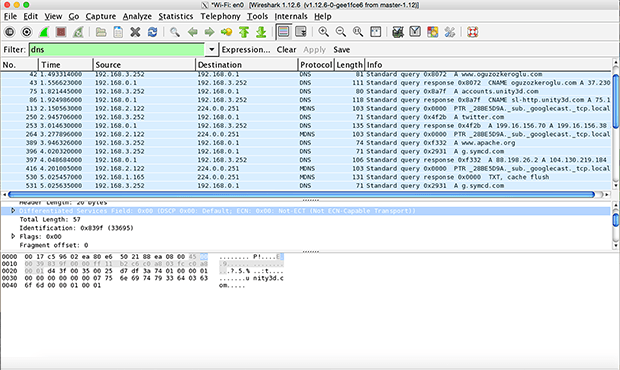
If you’re a regular home user, you may find it too difficult to use even with the help of various online tutorials. What’s more, to use Wireshark to its maximum potential, you need to have a compatible Wi-Fi card that supports all Wireshark’s network analysis modes.
-
Powerful features
-
Popular, supported network analysis solution
-
Free and open source
-
Very difficult to use
-
Don’t work equally well with all Wi-Fi cards (especially in Wi-Fi traffic capture mode)
-
Doesn't display heat maps or provide direct recommendations for channels or router placement
Acrylic is a Wi-Fi network scanner for Windows capable of scanning 802.11a/b/g/n/ac/ax networks on 2.4, 5 and 6 Ghz wireless frequencies, including support for Wi-Fi 7. It provides advanced tools for troubleshooting, including real-time monitoring, packet analysis, and SNR (Signal-to-Noise Ratio) assessment to evaluate signal quality.
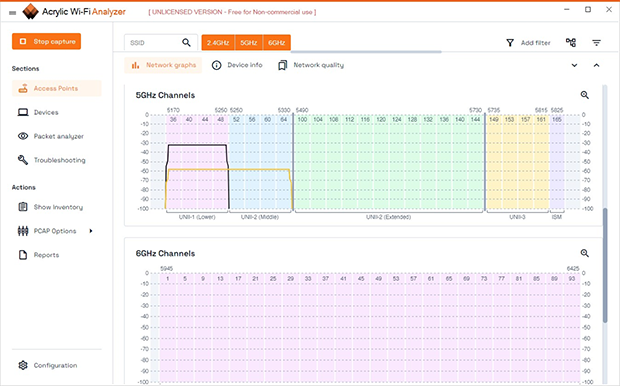
Additional features include packet loss detection, channel optimization recommendations, and the ability to export data in PCAP format. Its user-friendly charts make it easy to spot signal issues and interference, offering a comprehensive overview of network performance.
-
Trial version available but with limited features
-
Support for the 6 GHz band
-
Simple and modern interface
-
Expensive perpetual license
Wi-Fi Analyzer by olgor.com is a popular Android app designed to analyze and optimize Wi-Fi networks that you can use to discover Wi-Fi networks in your area and pick the least cluttered channel for your own network. The app supports 2.4 GHz, 5 GHz, and 6 GHz bands and can display channel width.
Wi-Fi Analyzer is compatible with Android 5 and newer, and it can be downloaded from Play Store for free. While not offering many features, Wi-Fi Analyzer has made it to the top of our list because of how convenient it is to have a solid booster app on a smartphone.
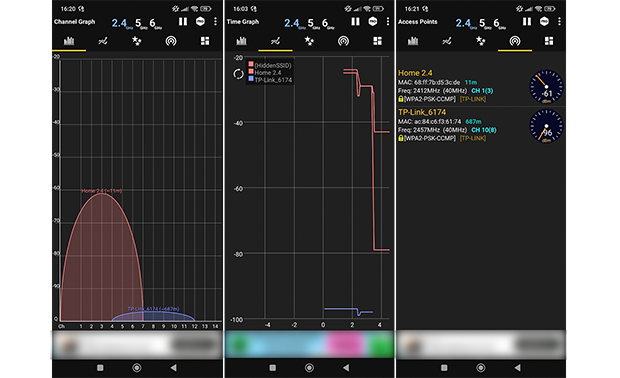
With Wi-Fi Analyzer installed on your smartphone, you can walk from room to room to discover where your Wi-Fi signal is the strongest and where it is the weakest. The app also provides real-time graphs and allows users to identify interference from neighboring networks.
-
Free
-
Convenient
-
Easy to use
-
Lacks features
-
Contains ads in the free version
Wi-Fi Analyzer is a handy tool for scanning local Wi-Fi networks. You can grab it from the Microsoft Store on Windows 10/11. While it’s not packed with advanced features, its user-friendly interface makes it easy to navigate.
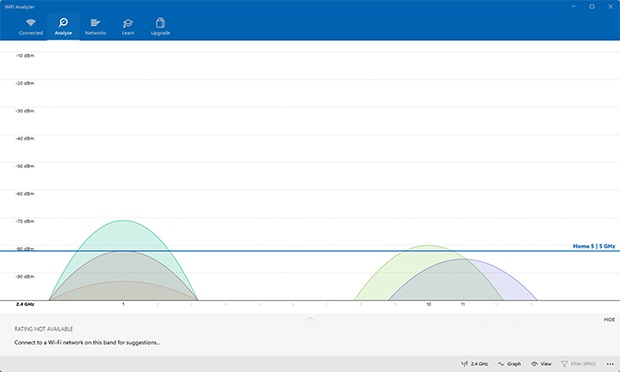
We recommend Wi-Fi Analyzer for quickly discovering which Wi-Fi channels in your area are overused and which are cluttered the least. As a "quick scanner from a laptop" this is often sufficient, although for creating coverage maps you will need to use other software.
-
Free
-
Simple
-
Available from Microsoft Store
-
Lacks features
WiFiman is a Wi-Fi and internet connection analysis app developed by Ubiquiti.
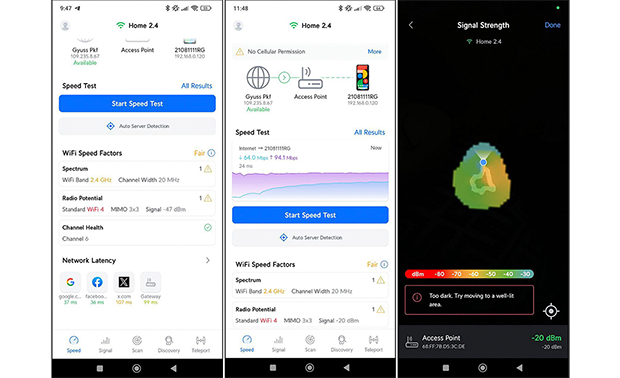
It provides detailed insights into available networks, helps identify the least congested channels, and offers support for Mesh systems.
-
Compatible with Ubiquiti hardware
-
Modern interface
-
Mesh system support
-
The interface can be difficult for beginners
Connection Stabilizer Booster helps maintain a stable link over mobile (3G, 4G, LTE) and Wi-Fi networks. It doesn’t physically boost signal strength, but instead reduces dropouts and automatically reconnects when needed.
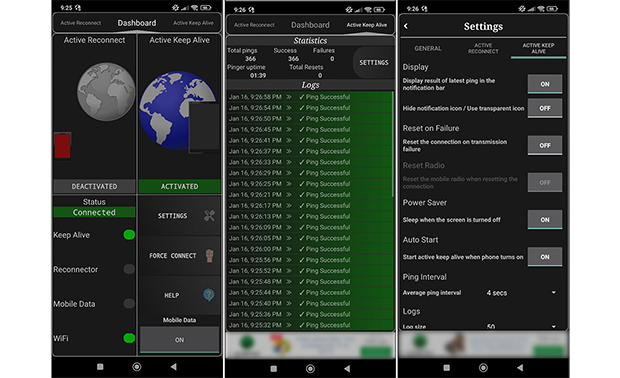
Main features:
- Keep Alive: keeps the connection active by sending background requests to avoid disconnections.
- Reconnection: automatically reconnects if the connection is lost.
- Force Connect: tries to force a connection even with a weak or unstable signal.
Connection Stabilizer Booster is useful for those who experience frequent connection breaks, especially in weak signal conditions. However, the application does not increase the physical power of the transmitted Wi-Fi signal.
-
Useful for stabilizing weak connections
-
Free and easy to use
-
Does not increase Wi-Fi power
-
Does not support network analysis or channel selection
Comparison Table
| Application | NetSpot |
| Wi-Fi 6/6E Support | ✅ |
| Ease of Use | High |
| Platforms | Windows, macOS, iOS, Android |
| Key Features | Heatmaps, channel analysis, planning mode |
| Real-World Testing Outcome | Most accurate and full-featured |
| Application | Wireshark |
| Wi-Fi 6/6E Support | ✅ |
| Ease of Use | Low |
| Platforms | Windows, macOS, Linux |
| Key Features | In-depth packet analysis |
| Real-World Testing Outcome | Most accurate and full-featured |
| Application | Acrylic |
| Wi-Fi 6/6E Support | ✅ |
| Ease of Use | Medium |
| Platforms | Windows |
| Key Features | Signal graphs, network scanning |
| Real-World Testing Outcome | Windows-only, Good technical depth, but paywalled, steeper to use |
| Application | Wi-Fi Analyzer (Android) |
| Wi-Fi 6/6E Support | ❌ |
| Ease of Use | High |
| Platforms | Android |
| Key Features | Channel visualization |
| Real-World Testing Outcome | Convenient but lacks export tools |
| Application | Wi-Fi Analyzer (Windows) |
| Wi-Fi 6/6E Support | ❌ |
| Ease of Use | High |
| Platforms | Windows |
| Key Features | Quick channel detection |
| Real-World Testing Outcome | Best for quick desktop scans |
| Application | WiFiman |
| Wi-Fi 6/6E Support | ✅ |
| Ease of Use | Medium |
| Platforms | Android, iOS |
| Key Features | Mesh support, detailed analysis |
| Real-World Testing Outcome | Good overview, less control |
| Application | Connection Stabilizer Booster |
| Wi-Fi 6/6E Support | ❌ |
| Ease of Use | Medium |
| Platforms | Android |
| Key Features | Stabilizes weak connections |
| Real-World Testing Outcome | Useful for flaky mobile/Wi-Fi |
How Can an App Help to Boost Wi-Fi Signal?
Some Wi-Fi booster apps such as NetSpot make it possible to create a detailed heat map showing the strength of your Wi-Fi coverage. Just like a weather map shows areas of exceptionally hot or cold temperatures, so does a signal heat map show the areas where your Wi-Fi router doesn’t reach.
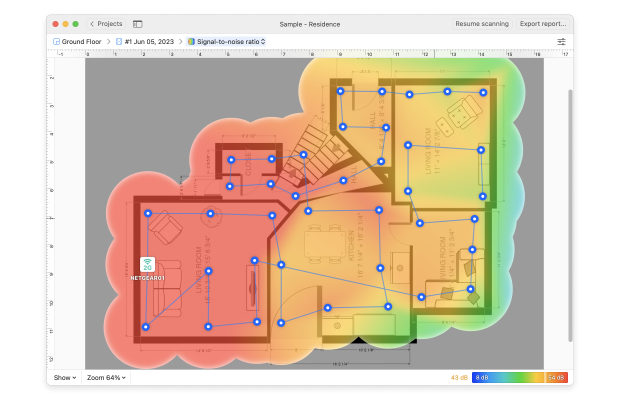
A signal Wi-Fi heat map is a great starting point on your way towards a stronger Wi-Fi as it allows you to determine the effectiveness of various Wi-Fi booster techniques. With the help of NetSpot, you can quickly and easily determine which router placement works best and adjust accordingly.
With NetSpot for Android you can, pretty much just as you would with the desktop version of the app, perform an in-depth analysis of WiFi networks with color-coded visual heatmaps and determine the most optimal spot to place your Wi-Fi router.

Perform an in-depth visual analysis and troubleshoot your Wi-Fi network with comprehensive color-coded heatmaps.

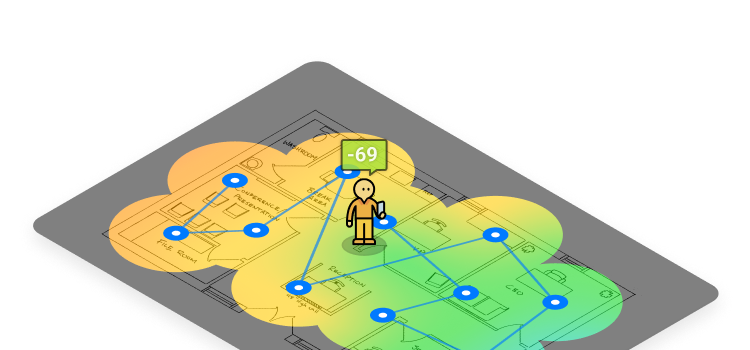
Likewise, NetSpot and many other Wi-Fi booster apps allow you to boost Wi-Fi signal by exposing overused Wi-Fi channels, which are like the lines on the highway. When all cars drive in a single line, you can expect traffic jams to occur and everyone to move slowly. But as soon as you switch to a different line, you can increase your travel speed because there are no cars in your way blocking you, and the same goes for Wi-Fi channels.
Conclusion
With a capable Wi-Fi booster app, you can greatly increase the performance of your home router and the strength of your wireless connection without a Wi-Fi enhancer. Even an older, less powerful router can surprise you with its range and stability when placed in the ideal location with a Wi-Fi analysis and maintenance tool such as NetSpot.
FAQ
Yes, many improvements can be made without purchasing new hardware. Optimizing router placement, changing to a less crowded Wi-Fi channel, and reducing interference from nearby devices can significantly improve performance. Apps like NetSpot can guide you through these adjustments with visual heatmaps and detailed analysis.
The very first and simplest thing you can do is play with your Wi-Fi router placement a bit. Ideally you want it in the very center of your space, slightly elevated is better than on the floor. Make sure there are no thick walls preventing the wireless signal from traveling where needed, and place your router away from kitchen appliances and other devices emitting electromagnetic waves.
A dedicated Wi-Fi analysis app like NetSpot can help you create a visual heatmap of your Wi-Fi coverage, which will clearly show where the signal needs a boost. A heatmap like that is a great start of a stronger Wi-Fi as it gives you the opportunity to evaluate the efficiency of different Wi-Fi boosting techniques.
By playing with different router placements and measuring Wi-Fi signal with NetSpot, you'll be able to tell which one works best for your network. A Wi-Fi booster app can also show you which Wi-Fi channels are overloaded and help you avoid them.
It depends on the job you need to do. For practical fixes and mapping, NetSpot is the easy starter — it runs on multiple platforms and, on Android, shows real heatmaps and channel tips you can act on. If you want packet-level forensics, use Wireshark. Windows users who need quick channel checks are fine with Wi-Fi Analyzer on Android or Windows. In Ubiquiti setups, WiFiman fits right in, and on Android, Connection Stabilizer Booster can help keep flaky links alive.
If you already have a new router or are not ready to get the latest version just yet, finding an optimal placement for your existing device might do the trick. With a Wi-Fi booster like NetSpot you can analyze your coverage and see how you can improve it.
Yes, there are many Wi-Fi booster apps that can help you improve your Wi-Fi signal and achieve flawless coverage throughout your home.
One such Wi-Fi booster app is called NetSpot, and we’ve selected it as the best Wi-Fi booster app available today because it successfully combines professional features with simplicity and usability, allowing anyone to quickly obtain highly accurate readings and use them to improve signal strength, eliminate issues with signal interference, and more.
There are several ways how you can increase your Wi-Fi signal strength without purchasing a new router:
- Download a Wi-Fi signal boost app and perform a network scan.
- Switch to a less busy Wi-Fi channel.
- Enable the 5 GHz band.
- Eliminate wireless signal interference.
- Update your router firmware.
- Add a wireless signal extender.
- Move your router to a more suitable location.
- Change your Wi-Fi password to kick off intruders.
Whatever you do to increase your Wi-Fi signal strength, make sure to use a Wi-Fi booster app to determine if the changes you made had the desired result.
Yes, Wi-Fi boosters do work, but they work differently than what many people think. Instead of magically improving Wi-Fi signal strength, Wi-Fi booster apps only provide the information you need to determine the optimal settings for your router. For example, they help reveal crowded channels, signal interference, and more. The most advanced internet booster apps can even create detailed maps of signal coverage, making it easy to find a more suitable place for your router.
They do, just not by “adding signal bars”. These apps give you real-time data about your connection so you can tweak it yourself — choosing better channels, spotting interference, and improving coverage where it drops. Think of them as diagnostic tools rather than magic boosters.
Yes, there are several Wi-Fi booster apps for iPhone, including NetSpot, which can perform an active scan of your WiFi network, measure the download and upload speeds, and create comprehensive WiFi heatmaps based on the collected data. These apps don't boost Wi-Fi signal directly, but they make it easy to see where the Wi-Fi coverage can be improved.





